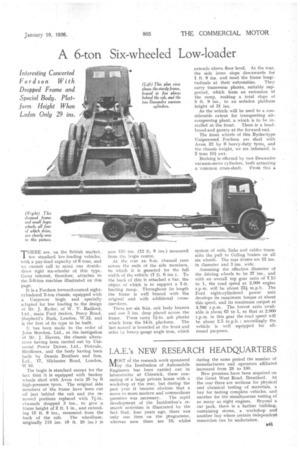A 6-ton Six-wheeled Low-loader
Page 59

If you've noticed an error in this article please click here to report it so we can fix it.
Interesting Converted Fordson With Dropped Frame and Special Body. Platform Height When Laden Only 29 ins.
extends above floor level. At the rear, the side irons slope downwards for 1 ft. 9 ins. and meet the frame longi tudinaLs at their extremities. They carry transverse planks, suitably supported, which form an extension of the ramp, making a total slope of 8 ft. 9 ins., to an unladen platform height of 31 ins.
As the vehicle will be used to a considerable extent for transporting aircornpresing plant, a winch is to be installed at the front. There is a headboard and gantry at the forward end.
The front wheels of this Ryder-type Unipowered Fordson are shod with Avon 32 by 6 heavy-duty tyres, and the chassis weight, we are informed, is 2 tons 101 cwt.
Braking is effected by two Dewandre vacuum-servo cylinders, both actuatieg a common cross-shaft. Front this a,
THERE are, on the British market, 1 few gtandard low-loading vehicles, with a pay-load capacity of 6 tons, and we cannot call to mind one doubledrive rigid six-wheeler of this type. Great interest, therefore, attaches to the 5-6-tbn machine illustrated on this page.
It is a Fordson forward-control eightcylinder 2-ton chassis, equipped with Uni ower bogie and specially adapted for low loading to the design of Mr. J. Ryder, of W. V. Radford, Ltd., main Ford dealers, Percy Road, Shepherd's Bush, London, W.12, and is the first of its type to be built.
It has been made to the order of John Mowlem, Ltd., at the instigation of Mr. J. Havers, the chassis alterations having been carried out by Universal Power Drives, Ltd., Perivale, Middlesex, and the body having been built hy Dennis Brothers and Son, Ltd., 17, Silchester Road, London, W.10.
The bogie is standard except for the fact that it is equipped with Sankey wheels shod with Avon twin 25 by 6 high-pressure tyres. The original side members of 'the frame have been cut off just behind the cab and the removed portions replaced with 7i-in. channels dropped 2 ins., to give a frame height of 2 ft. 1 in., and extending 15 ft. 9 ins., measured from the back of the cab. The wheelbase, originally 118 ins. (9 ft. 10 ins.) is
now 153 ins, (12 ft. 9 ins.) measured from the bogie centre.
At the rear an 8-in, channel runs across the ends of the side members, to which it is gusseted for the full width of the vehicle (7 ft. 6 ins.). To the back of this is attached a bar, the object of which is to support a 7-ft. loading ramp. Throughout its length the frame is well braced with the original and with additional crossmembers.
There are six 6-in, oak body bearers and one 3 ins, deep placed across the frame. These carry 11-in, ash planks which form the 14-ft. platform. The last named is bounded at the front and sides by heavy-gauge angle iron, which
system of rods, links and cables transmits the pull to Girling brakes on all six wheels. The rear drums are 12 ins. in diameter and 3 ins. wide.
Assuming the effective diameter of the driving Wheels to be 27 ins., and with an overall top gear ratio of 713 to 1, the road speed at 2,000 engine r.p.m. will be about 224 m.p.h. The Ford eight-cylindered power unit develops its maximum torque at about this speed, and its maximum output at 8,700 r.p.m. The lowest ratio available is about 63 to 1, so that at 2,000 r.p.m. in this gear the road speed will be about 2.5 m.p.h. ; accordingly the vehicle is well equipped for allround purposes.




































































































